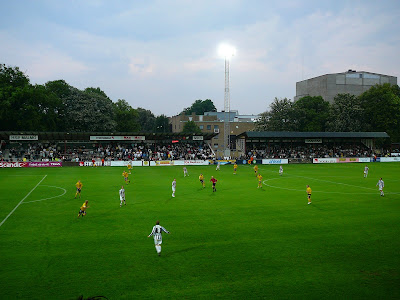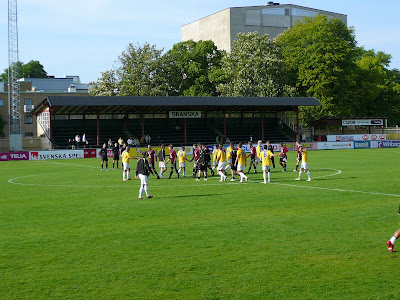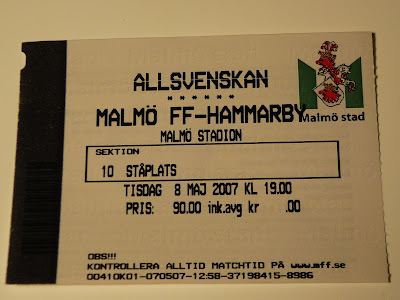Bunkeflo IF – Landskrona BoIS (
Almost exactly 24 hours after leaving Malmö IP I was back for more. This time at the program, the Skånederby of the Superettan (

While the day before a mere 250 people had been at Malmö IP, to see IFK Malmö-Qviding FIF, today it was a completely different ballgame. When approaching the stadium, a couple of minutes before kick-off, I could hear singing and hundreds of bicycles were obstructing the way to the entrance of the ground. In fact, according to the official count an impressive 5,462 people were present, at least 2,000 of them were black-and-white striped supporters of Landskrona BoIS.

This time I headed directly to the sausage stand. Unfortunately, when I was finally served my sausage was still cold inside. A particular shame as the aivar and tartar sauce, which were freely available, tasted great. It was strange to be back in the same stadium, as it felt so different. It was now almost full and the atmosphere was electric. There was a real game going on! In fact, it was not easy to find a good spot. The main stand in particular was packed.

While I was circling the ground to take some pictures, I saw a group of some ten away supporters standing with their hands against the wall. They were arrested by the police, which were present in relatively large numbers, although I don’t know why. Throughout the game I was surprised to see small groups of supporters of both teams touting each other so openly; something I hadn’t experienced at Swedish games before. Something else I hadn’t seen before, neither in

After circling the ground, I took my place at the main stand, among both Bunkeflo IF and Landskrona BoIS fans, and saw a decent start of the game. The level was clearly better than the day before. Also, these players did not shy away from serious tackles. While I thought that the visitors had a little bit more of the game, it was in fact the home team that scored the first and only game of the first half, captured by yours truly.

The second half started with a huge chance for the visitors, but he missed it at 5 meters before the goal. While the game deteriorated rapidly, with both teams excelling only in bad passes and wrong choices, the second half proved full of goals. In the 58th minute Bunkeflo IF scored the 2-0 through a scrimmage goal. Only five minutes later it was already 3-0 after a nice sliding-shot from 11 meters.

This was too much for most away supporters. The fans behind the goal finally stopped their singing, which had increasingly been anti-Malmö rather than pro-Landskrona, while their fellow-supporters throughout the stadium started to leave by the hundreds. In fact, when the visitors had their best chance of the game, in the 83rd minute, which brought a great safe by the BIF goalie, almost one-third of the spectators (mostly away fans) had left the stadium. They missed a stunning finale.

In the 89th minute a BIF striker went alone on goal but failed and in the direct counter-attack a BoIS player placed a hard shot only just wide of the goal. In the 91st minute the away team got their deserved “honorary goal”, although the nice combination of the visitors was finished with an own goal of a BIF defender. This would not be the final score though. In the dying seconds of the 94th minute Bunkeflo IF scored its fourth goal. 4-1 would also be the end result of this Skånederby.

All in all, it was an Erlebnis to have two such totally different experiences in the same stadium in two days. It shows that Malmö IP is a very nice home ground for whatever crowd, team, and weather. It also shows that Malmö has much more to offer than just Malmö FF. In fact, given its close proximity to










































